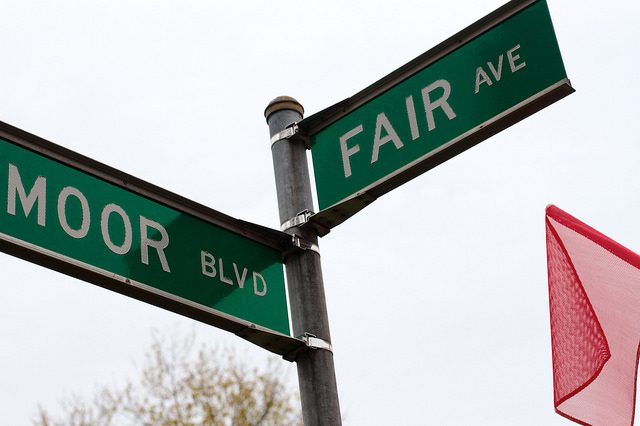
Photo credit: Alan Levine, via flickr, CC BY 2.0
The Community Reinvestment Act (CRA) is a law that requires banks to serve the credit needs, consistent with safety and soundness, of all communities, including low- and moderate-income communities. With this requirement, CRA is essentially aimed at making capitalism work better in all communities. Any hardworking citizen with good credit should be able to secure a loan and participate in the capitalist economy by using the loan to buy a home or start a small business. This ethic is consistent with both liberal and conservative notions that all Americans should have a fair chance to pull themselves up by their own bootstraps and take responsibility for providing for their families and bettering their communities.
Unfortunately, in the current climate, support for CRA is becoming more partisan, even though prominent Republicans and banks have supported CRA as a positive economic force.
Let’s review the record of CRA supporting robust community economies:
• Since 1996, CRA-covered banks issued more than 24 million small business loans in low- and moderate-income tracts, totaling more than $973 billion. NCRC research has corroborated other research demonstrating that small business lending increases at a county level as the number of bank branches increase on a county level.
• A Harvard University study, “The 25th Anniversary of the Community Reinvestment Act: Access to Capital in an Evolving Financial Services System,” demonstrates that without CRA, home purchase lending to low- and moderate-income borrowers and communities would have decreased by 336,000 loans from 1993 through 2000.
• In a speech, former Federal Reserve Board Chair Ben Bernanke reported that a paper by Federal Reserve Board economists found that low- and moderate-income tracts targeted by CRA had higher homeownership rates, higher growth in owner-occupied units, and lower vacancy rates than would have otherwise been predicted. In other words, CRA motivated banks to make more viable loans in these tracts than would have been the case without it.
How does CRA produce these results? CRA provides an incentive for banks to increase their responsible lending to low- and moderate-income borrowers and communities by rating banks on their lending, investment, and service performance to these populations. These ratings are made public and are a factor as to whether regulators approve bank mergers.
Why is the CRA encouragement needed? Neo-classical (conservative) economic theory discusses that market failure occurs when barriers impede the flow of information. Information barriers exist in low- and moderate-income markets that have prevented banks from making an optimal number of responsible loans to modest income borrowers.
For example, since home buying and appraisal activity is lower in low- and moderate-income neighborhoods compared to affluent neighborhoods, banks find it more difficult to obtain information on home values. Likewise, since a segment of lower-income borrowers lack established credit histories, banks find it harder to underwrite loans to them. It is not the case that lower-income neighborhoods lack solid homes or creditworthy borrowers; it is simply harder for banks to find lending opportunities. These opportunities exist, but will be overlooked as banks naturally pay more attention to affluent markets where there is more abundant information about homes and buyers.
CRA corrects for these market imperfections by requiring banks to make more of an effort to obtain information about safe and sound lending opportunities in lower-income neighborhoods. And a Federal Reserve study confirms that CRA has effectively corrected for market failure by showing that CRA loans are profitable. Such loans would not be profitable if CRA did not successfully correct for market failure.
So if CRA is improving capitalist markets in all communities, why the fuss? Some ideologues suggest that CRA is credit allocation or the government requiring quotas of loans for underserved populations. But these criticisms fail because CRA is not credit allocation but an examination regime that urges banks to find more responsible lending opportunities in communities.
Writing in the National Review, Howard Husock, vice president of Research and Publications at the Manhattan Institute claims that, “The message to the poor is pernicious: A borrower qualifies for a mortgage on the basis of “need” or zip code, rather than accomplishment and adequate income. Worse still, those who make good life decisions and keep current on their loans are at risk that their neighbors—who may have gotten loans simply to fulfill CRA rules—will not. The result: neighborhood decline.”
Husock continues, “If the CRA ever made sense, it no longer does. Rebuilding our inner cities, as promised by President-elect Trump, requires sound investments based on potential returns on investment, not yet another generation of dead-end subsidy and capital-allocation efforts.”
In Mr. Husock’s view, CRA is a quota requirement to serve negligent and non-creditworthy people rather than an incentive to overcome market imperfections and find creditworthy people buying sound homes. For Mr. Husock to be correct, the evidence would have to point to irresponsible CRA loans with high default and delinquency rates. Some ideologues have tried to make this claim, but in looking at what careful economists and researchers at the Federal Reserve have to say, we learn:
• Research by Elizabeth Laderman and Carolina Reid of the San Francisco Federal Reserve Bank documents that loans made by banks in their CRA geographical areas are about half as likely to end up in foreclosure as loans issued by non CRA-covered mortgage companies.
• Federal Reserve economists Neil Bhutta and Glenn Canner analyzed 2005–2006 data from the Home Mortgage Disclosure Act (HMDA) and revealed that only six percent of all higher-priced loans (which is used as a proxy for subprime loans) were “CRA-related”—that is, made by banks to either lower-income borrowers or lower-income neighborhoods in the banks’ CRA geographical areas. If CRA was forcing credit allocation, it would seem that banks would be flooding lower-income areas with high cost and risky loans since they would have to lower underwriting criteria to serve these borrowers. But Federal Reserve evidence refutes this notion.
Steve Bannon, chief strategist to President Trump, is no fan of CRA. When he was a movie producer, he wrote a documentary film called Generation Zero in 2010 in which the narrator states, “When Bill Clinton became president he made turbocharging the Community Reinvestment Act one of his priorities. He got the Justice Department to go after mortgage lenders to say that if these lenders were not making proportionate loans they can be accused of racism. So this had the effect of corroding lending standards. This is what created the explosion of subprime lending during the Clinton years and the Bush administration years.”
Not only is this incorrect based on the data in Federal Reserve studies, but it is also a blatant attempt to pit minorities against whites. CRA has had a tremendous benefit to working class whites as well as predominantly white and poor rural areas. NCRC’s study for the Appalachian Regional Commission documents that banks headquartered in the region made $8.8 billion of community development loans and investments for affordable housing and economic development during the CRA exam time periods of roughly two to three years.
During the George W. Bush Administration, Bush appointees to the federal agencies defended CRA as a law requiring and creating safe and sound lending. FDIC Chair Sheila Bair, a Bush appointee, remarked concerning CRA and the financial crisis, “I want to give you my verdict on CRA: NOT guilty.” Other Bush appointees including Randall Kroszner, a member of the Federal Reserve Board, and Comptroller of the Currency John Dugan made similar remarks. So did a number of banks that rose to the defense of CRA. Mr. Michael Middleton, President and CEO of Community Bank of Tri-County, Maryland, testifying on behalf of the American Bankers Association before the House Committee on Financial Services in 2009, cited CRA’s positive impact. He stated, “We really find the CRA as a tool, not an obstacle, and I mention also that all of our affordable housing loans are current, none of them are in default.”
When a law supports capitalism, wealth building, and pulling oneself up by one’s own bootstraps, it must receive bipartisan support consistent with the views of both liberals and conservatives. And when it delivers safe and sound loans, the business dealmaking and non-ideological side of President Trump should approve. CRA is one of the best hopes for America because it seeks to restore banks as one of the most important institutions in the economic life of our neighborhoods.






Blaming CRA, along with FNMA and Freddie Mac, is the “alternative facts” narrative used to exonerate the finance industry for sinking the economy through its predatory and exploitative behavior of developing, selling and securitizing toxic mortgage products in a deregulated environment, where those who were supposed to maintain the integrity of the marketplace–such as appraisers, ratings agencies, government regulators and the legislatures–were being bought off.
Unfortunately blaming “those people,” generally poor people and minorities, and their manipulators in government has more emotional power today than a reasoned review of the data and studies that Josh has collected. What needs to gain emotional power is the value in building up the wealth of people throughout the society, who the financial system should exist to serve and not exploit.